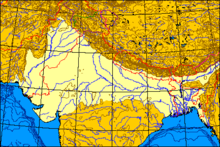
The Punjab Plain is a large alluvial plain in Eastern Pakistan and Northwestern India. The plain includes the Pakistani province of Punjab and the Indian states of Punjab and Haryana, and parts of Rajasthan. This plain is around 200–300 meters above mean sea level. The plain is extensively farmed for cereals and cotton.[1]
The plain is the western part of the Indo-Gangetic Plain, which is formed by the Indus River and its tributaries - the Jhelum, the Chenab, the Ravi, the Beas and the Sutlej.
The land formed of alluvium in between two rivers known as Doab is found here.
Bhangar : The flood plains formed due to deposition of older alluvium is known as Bhangar.
Bet : The flood plains seen here which are formed due to repeated deposition of new alluvium during each flood is known as Bet. The plains are in the plain biomes.
References
[edit]- ^ "Punjab Plain | plain, India". Encyclopedia Britannica. Retrieved 13 April 2017.
Well, that’s interesting to know that Psilotum nudum are known as whisk ferns. Psilotum nudum is the commoner species of the two. While the P. flaccidum is a rare species and is found in the tropical islands. Both the species are usually epiphytic in habit and grow upon tree ferns. These species may also be terrestrial and grow in humus or in the crevices of the rocks.
View the detailed Guide of Psilotum nudum: Detailed Study Of Psilotum Nudum (Whisk Fern), Classification, Anatomy, Reproduction